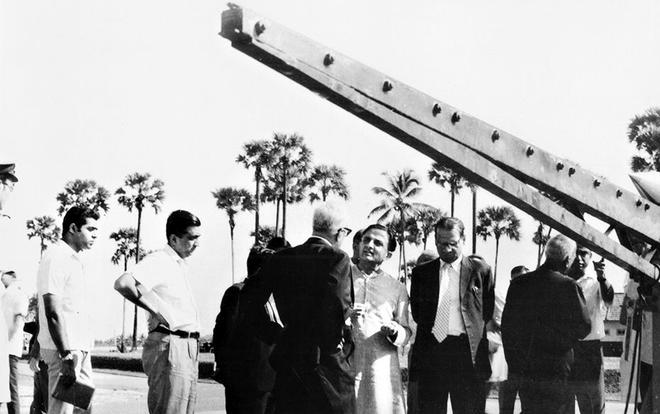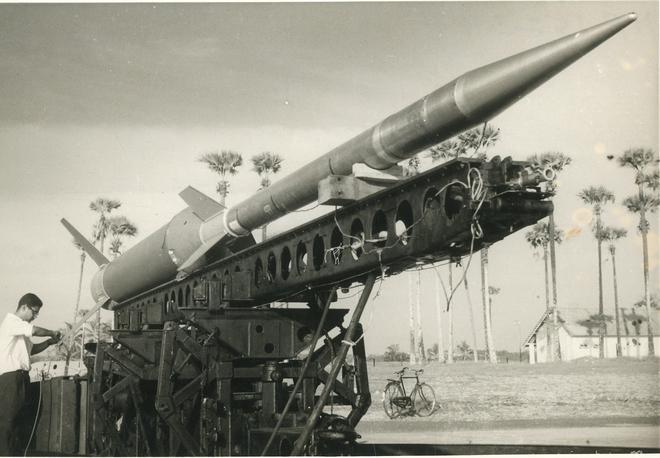Sixty years ago, the Indian space programme was born.
On the evening of November 21, 1963, a 715-kg Nike Apache rocket soared from a small launch pad on the beach-head at Thumba, a fishing village on the outskirts of Thiruvananthapuram. It rose 208 km into the sky and released a sodium vapour payload, painting the twilight sky with a big, bright orange cloud.
The Kerala Assembly was in session at the time in Thiruvananthapuram. Its members ran out to see the spectacle in the sky. They were entranced. The sight fascinated thousands of people in the area. Some of them later said that the launch hooked them to rocketry and motivated them to join the Indian Space Research Organisation (ISRO).
The Nike Apache launch was an international effort under the United Nations. The rocket came from the U.S., the sodium vapour payload from France, and the range clearance from an MI-4 helicopter from the then Soviet Union. The rocket and payload engineers were Indians.
The rocket had been mated with the payload in St. Mary Magdalene Church, Thumba, which had been taken over by the national government. The parish priest’s house served as the mission control centre.
Vikram Sarabhai was present during the launch, as were E.V. Chitnis, P.D. Bhavsar, A.P.J. Abdul Kalam, and the French payload specialist Jacques Blamont, among others.

India launched its first truly indigenous rocket on February 22, 1969. Vasant Gowariker, who later became the Director of Vikram Sarabhai Space Centre (VSSC), Thumba, said it was “a pencil-sized rocket”. He told this writer in 1980 that it carried a few kilograms of solid propellants and rose a few kilometres into the air.
On November 21, 2003, ISRO celebrated 40 years of Indian rocketry at the VSSC. Dr. Blamont was present as the many attendees, including Dr. Gowariker, R. Aravamudan, and G. Madhavan Nair competed to pay generous tributes to Sarabhai. They praised his “charisma” and “magnetic personality”, and commended his knack of attracting brilliant talent to ISRO.

Abdul Kalam, who had become the country’s President in 2002, addressed ISRO engineers from Rashtrapati Bhavan. He began his speech with a countdown that elicited thunderous applause. “I was a payload fellow” during the Nike Apache mission, he said, to more cheer.
A new era
On July 18, 1980, India became part of a select club of nations when its home-grown Satellite Launch Vehicle-3 (SLV-3), weighing 17 tonnes, placed the 35-kg Rohini satellite into orbit. The only other countries with the ability to put their satellites into orbit using their own launch vehicles were the Soviet Union, the U.S., the U.K., and France.
The SLV-3s were followed by the Augmented Satellite Launch Vehicles (ASLVs), the Polar Satellite Vehicles (PSLVs), and the Geo-stationary Satellite Launch Vehicles (GSLVs). The PSLVs and its variants have of course become ISRO’s trusted workhorse. India also has a variety of sounding rockets to study the upper atmosphere.
ISRO has had its share of failures – including its first SLV-3 flight in 1979, its first two ASLV flights, the first PSLV mission, and a few GSLV missions. The organisation has had trouble accepting the fate of these missions as such, preferring to call them “partial successes”. But to its credit, it has also eventually vaulted to full successes.
Today, India is an influential spacefaring nation. On July 14, 2023, in its M-4 mission, a Launch Vehicle Mark 3 (LVM-3) weighing 640 tonnes lifted off from the second launch pad at Sriharikota and placed the four-tonne Chandrayaan-3 composite module into an orbit around the earth.
On August 23, 2023, the Chandrayaan-3 lander, named ‘Vikram’, soft-landed on the moon, and a few hours later, a rover named ‘Pragyaan’ rolled out onto the lunar surface. The success made a new kind of history for India.
ISRO Chairman S. Somanath called the feat “the beginning of a golden era” and said Chandrayaan-3 was a “made in India craft”. In his assessment, the mission’s “most critical event” was the launch of the LVM-3 rocket itself, as it was completely autonomous.
On the strength of its rockets, India has been able to build and launch satellites for a variety of applications, including remote-sensing, weather-forecasting, communications, navigation, surveillance, tele-education, cartography, prospecting resources, etc. It has also embarked on deep-space science missions to study the moon, Mars, the Sun, and distant stars.
“India has assured access to space,” in the words of the late S. Ramakrishnan, a reputed rocket technologist and former Director of VSSC. “It can build any type of launch vehicle and any type of satellite. Using these launch vehicles, it can put its satellites into different types of orbits.”







